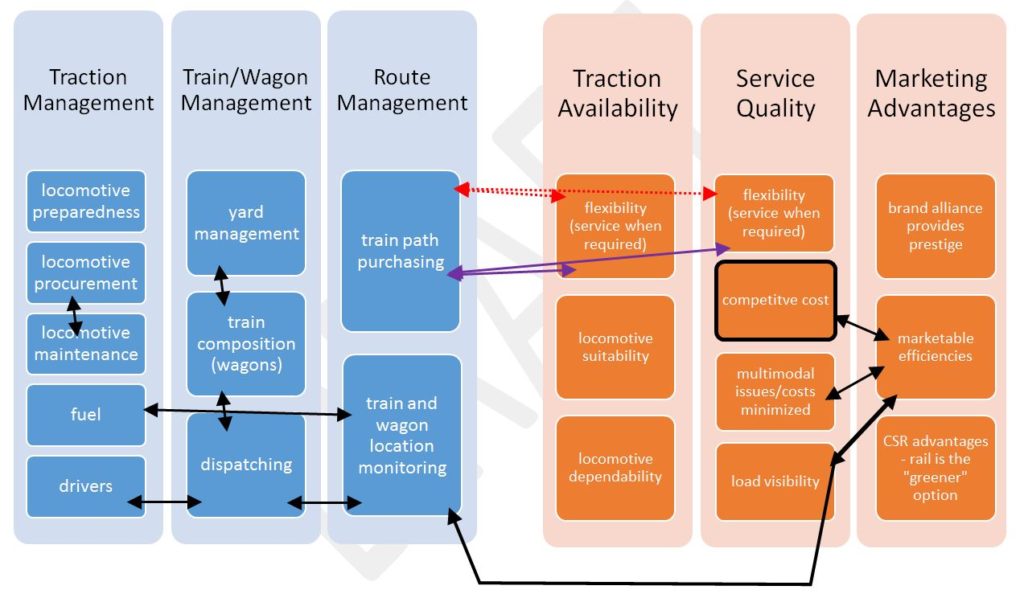Relating Core Rail Freight Functions to Customer Value-Drivers

This diagram outlines the value driving-significance of rail freight operations.
Blue indicates core rail freight functions; orange indicates customer value-drivers. Solid lines indicate direct translations of function capabilities into customer value drivers.
Red dotted lines indicate major challenges, i.e. conflicts of function/systemic capabilities and customer value-drivers.
Competitive cost as a value driver is enclosed in black. In terms of core functions, this driver is attained by value captured in each constitutive activity.
In the case of trainloads, i.e. multiple wagons carrying a single commodity from point to point, train/wagon management is vastly simplified. Thus, the yard and composition activities (second column of the core functions) can be disregarded. This reduction in activities manifests as economies: the trainload principle harnesses the advantages of rail freight more fully than mixed freight/wagon loads, since wagon load trains require personnel and infrastructure, in the form of marshalling yards, staff, and coordination, all of which represent cost/time.
The advantages of the rail freight business model are unambiguously expressed in the example of the coal-burning power station that is served by a merry-go-round (MGR) model. In the MGR, trains run continuously and exclusively between two points – point of loading and point of delivery. The load is simple, singular, and in predictable volumes. Its handling is also uncomplicated. The rigidity of the MGR loop eliminates the costly activities of route planning and train configuration. Moreover, the point of extraction is the point of collection and the point of delivery is the point of consumption, obviating need for any intermediate modes of transport.
In supply chain terms, demand is known, perfect and constant. Rate of consumption is correspondingly predictable and steady. Supply activities are steady state. When such symmetry between demand and supply is possible, the advantages of rail freight are exploitable. Rigidity, which is antithetical to response-driven/”agile” supply chain configurations, becomes an advantage. The system provides levels of certainty impossible to realize in consumer-serving models, where supply response is determined by patterns of customer “pull”.
[read more=”Click here to Read More” less=”Read Less”]
Demand-driven “pull” systems attempt to scale and time supply according to customer needs. Flexibility/agility is desirable, but the feasibility of on-demand delivery is geared to the characteristics of the modality. Cost increases with complexity. The activities that represent complexity (traction management, train composition, and route planning/path purchasing) can be converted to competitive advantage generators by the addition of resources, improved management, and understanding of current and likely customer requirement. Rationalisation of facilities might also be considered, since there exists the likelihood that the location of key activities is strongly determinative of economic performance. If labour-intensive activities can be performed in lower cost regions that are within profitable distance of important customers, savings ought to be possible.
The usual constraints of freight by rail apply. These constraints are imposed by the nature of the modality, so are unavoidable. These constraints are as follows:
- Rail freight is delivered by locomotives pulling and pushing wagons or tanks on immovable, high maintenance, track. Permanent way modalities are intrinsically inflexible.
- Train path purchase requires accurate demand forecasting. Since rail networks are controlled and regulated by local authorities, train paths (scheduled routing) must be purchased by the network operator, which might be a regional or national entity. Train paths can be “catalogue paths” or “tailor-made” paths: the former signifying a common or standard route with common or standard timetabling; the latter signifying a customer-specified route.
- Point-to-point conveyance necessitates multimodal interoperations, i.e. in the case of goods, road vehicles are required to link the railhead or strategic rail hub to points of consolidation or distribution, such as retailer premises, warehouses, or distribution centres. The transfer process incurs cost/time and complexity/risk. Coordination with other modalities increases primary and secondary risk. Primary risks relate to demurrage and buyer refusal of loads due to delays resulting from handling and transfer. Secondary risks include security, handling damage, and the possibility of brand reputation erosion.
- Loading gauges also differ by region and nation. “Loading gauge” refers to the minimum clearance that bridges and tunnels must provide for the safe passage of rail vehicles. In the UK, upgrading of the major intermodal routes for the purpose of accommodating passage of the new “high cube” (9’ 6”) shipping container is ongoing. Routing into Europe freight that originates in the UK is seldom problematic, since the UK’s traditional loading gauges are the most restrictive. Routing into the UK freight that originates in Europe is likely more challenging, as European (including Irish) loading gauges are significantly more generous. Loading gauge compatibility thus represents an additional layer of routing complexity.
- Electric locomotive power is, in terms of pure traction, as functionally capable as diesel locomotive power, but electric traction has higher infrastructure dependency and sensitivity. Power supplies differ by national and regional boundaries. Significant areas of Europe (most of Scotland and Ireland for example) lack electrification. The availability and characteristics of national and regional rail electrification systems thus influences locomotive selection. Not requiring external electrical supply, diesel locomotives can run on both electrified and non-electrified routes, so offer greater route planning flexibility. The ubiquity of diesel fuel supply represents another advantage of diesel locomotives in international, or inter-regional freight.
[/read]
